The Spider vs. The Empire State
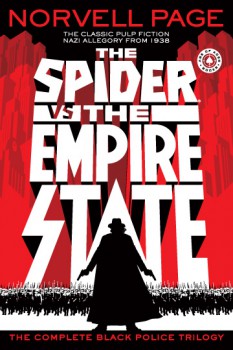 The Spider Revival: Part III
The Spider Revival: Part III
The Spider vs. The Empire State
Norvell Page (Ace of Aces Books, 2009)
I have previously written about the revival in trade paperback of the adventures of The Spider, the bloodiest of all 1930s pulp heroes. My reviews of The Spider: Robot Titans of Gotham and The Spider: City of Doom, both published by Baen, contain plenty of background about the character and his main author, Norvell Page, so if you’re unfamiliar with the blood-soaked vigilante insanity of this region of the pulp universe, I’d advise that you start there.
This third collection of Spider adventures comes from a new publisher (Ace of Aces Books) and presents for the first time three connected novels that were originally published consecutively in The Spider Magazine. These three novels, which ran in the September, October, and November 1938 issues, form “The Black Police Trilogy,” one of the darkest episodes in the character’s history. Norvell Page and his editor Harry Steeger decided to put newspaper headlines and national fears into their pulp adventures: an allegory for Nazism, viewed as it might arise in the middle of contemporary New York State. It Does Happen Here might serve a good alternate title.
The first book of the trilogy, The City That Paid to Die, came out exactly a year before the Nazi invasion of Poland. The U.S. and the rest of the world were in an uneasy position with the seemingly unstoppable rise of fascism in Europe and the apparent weakness of the liberal democracies. A few small fascist sympathetic groups bubbled up in the U.S., but by 1938 the isolationist nation was becoming concerned about the ambitions of the regimes of Adolf Hitler and Benito Mussolini. It was an era ripe for terror and panic—and Norvell Page seized those feelings to create a pulp adventure uncomfortably close to 1938 concerns.
Pulp literature often had a way of slipping the fears of its era into it. Although capable of delivering romantic and exotic thrills, pulp also had its fingers on the febrile pulse of the populace. Norvell Page’s Spider novels put the lie to the “Great Generation” myth, pulling up the stone of the 1930s and watching the weevils swarm in the dirt beneath. “The Black Police Trilogy” is one of the most obvious examples of a pulp writer latching onto his society’s anxieties.
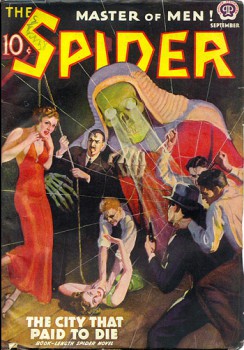 Page imagined what a U.S. fascism for the late 1930s might look like: The Party of Justice, a criminal-run political group that seizes control of New York City through sweeping elections and the manipulation of greedy industrialists. It then unleashes a reign of terror and repression through its army of black-shirted ersatz SS soldiers—The Black Police—whom only the Spider can stop. The Spider doesn’t act alone, but turns himself into a public champion of the forces of resistance across the state.
Page imagined what a U.S. fascism for the late 1930s might look like: The Party of Justice, a criminal-run political group that seizes control of New York City through sweeping elections and the manipulation of greedy industrialists. It then unleashes a reign of terror and repression through its army of black-shirted ersatz SS soldiers—The Black Police—whom only the Spider can stop. The Spider doesn’t act alone, but turns himself into a public champion of the forces of resistance across the state.
Yet here’s a very disturbing truth: As horrible as Norvell Page makes his villainous Party of Justice and their blackshirt goons, the Nazis would do far worse. Page’s supervillains pale compared to the reality. The human race should not feel proud that we superseded a feverish fictional pulp nightmare.
Page wasn’t writing a dissertation when he typed out the three “Black Police” novels, however. They are delirious action pieces before all else, and Page never dwells on the philosophies of fascism, merely its trappings and its actions. The Black Police movement is not made up of nationalist fanatics following a self-proclaimed Messianic Leader with a belief in a superior race and destiny that involves the elimination of racial “others.” They’re just crooks who have grabbed the best scheme possible: turn themselves in the police. At the deeper level, the Black Police aren’t truly fascists according to the definition that modern historians use; they are standard “Spider” super-criminals masquerading as a political movement. The Black Police are more important for the way they reflect the anxieties of the U.S. than for any attempt to actually comprehend how fascism started in Europe and what it meant.
Okay, I’ll step away from the academic lectern and open up the wood-pulp pages (or acid-free reprints of them) that tell the violent, feverish adventure story. . . .
* * *
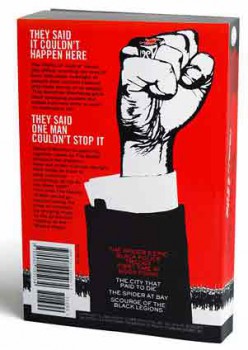 The first novel, The City that Paid to Die, wastes no time leaping into the situation. (Norvell Page never wastes time.) The Party of Justice has already come to power, sweeping elections to control New York State. Its leaders are major industrialists who want to line their pockets with sweeping de-regulation and heavy taxation of the poor. But the Spider—in his civilian identity of Richard Wentworth—has worse news for Police Commissioner Stanley Kirkpatrick: the Party of Justice gained power with the help of criminals, and the criminals are about to seize complete control of the party and all of New York with it.
The first novel, The City that Paid to Die, wastes no time leaping into the situation. (Norvell Page never wastes time.) The Party of Justice has already come to power, sweeping elections to control New York State. Its leaders are major industrialists who want to line their pockets with sweeping de-regulation and heavy taxation of the poor. But the Spider—in his civilian identity of Richard Wentworth—has worse news for Police Commissioner Stanley Kirkpatrick: the Party of Justice gained power with the help of criminals, and the criminals are about to seize complete control of the party and all of New York with it.
The Spider flies to Albany to confront Governor Whiting after the politician creates the New York Bureau of Investigation, a force of blackshirts who coerce the draining tax from poor citizens—often immigrants—at gunpoint. The NYBI leader is criminal Jack Strong, which convinces the Spider that Mayor Culkin and Governor Whiting are simply puppets for a force of gangsters.
The mastermind behind the rise of the Black Police is a mysterious white face that appears in the mirrors of the puppet rulers and is know only as “The Master.” (This is a key place where Page’s evil government fails the fascist test: there’s no Cult of Personality around an ultra-leader who makes Messianic claims, only the pulp-standard mystery mastermind who remains behind the curtains.)
If readers are going to stay with the three-book epic, they have to accept the improbably sudden seizure of power that hands all state government of the most populous state in the world’s largest elective democracy to crazed lunatics who shoot poor store owners when they don’t fork over $200 in tax on demand, and then drag other resistors behind the backs of their trucks. Just accept it now—think of the Nazis and the allegory Page is trying to compose—and prepare for the rest of the hellbending ride.
In Albany, the Spider breaks into the capital to secretly broadcast the governor’s speech to the public. When the governor announces a new law that allows the state government to declare anyone a “public enemy” and seize their lands and kill them, the Spider also makes his own announcement—putting himself publicly as the face the resistance against the Party of Justice and the Black Police.
The Spider makes a dash back to New York City to join forces with Stanley Kirkpatrick. Both Kirkpatrick and the Spider’s secret civilian identity (never apparently much of a secret) have been declared Public Enemies with hefty prices on their heads. Wentworth’s love, Nita, and his servant Ram Singh have been busy in his absence, fighting against the terror that the Black Police have unleashed onto the city. They also have a new ally, young Jack Wilson, a tax collector who breaks ranks when he witnesses the brutality of the NYBI.
The depravities of the Party of Justice increase: public hangings for resistors, concentration camps, and badges to identify who has paid for special “fundraising” and who has not. As the first novel ends, the Spider has gathered a resistance movement in the Catskills and made the first concentrated strikes at the Black Police. The Spider has also discovered the identity of the Master, and in true Norvell Page fashion, it’s somebody the reader hardly had a chance to know from earlier in the story. But the Master slips into a new identity so the guessing can go on in the sequel. And the sequel after that.
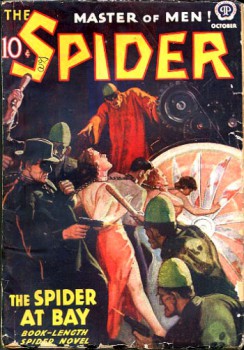 The City That Paid to Die moves fast, like most Spider novels, but Page sometimes has it going too fast, and he skips through set-pieces that he should spend more time working: the Spider in a trap made from a sort of proto-microwaves (a rare appearance of the sort of super-tech that fill other Spider novels), a rescue attempt during a mass-hanging in Union Square, and an assault on a concentration camp. The novel is good set-up material for a trilogy, but it’s not one of the better Spider novels, since it misses the one memorably nasty centerpiece that these books need to push them over the top.
The City That Paid to Die moves fast, like most Spider novels, but Page sometimes has it going too fast, and he skips through set-pieces that he should spend more time working: the Spider in a trap made from a sort of proto-microwaves (a rare appearance of the sort of super-tech that fill other Spider novels), a rescue attempt during a mass-hanging in Union Square, and an assault on a concentration camp. The novel is good set-up material for a trilogy, but it’s not one of the better Spider novels, since it misses the one memorably nasty centerpiece that these books need to push them over the top.
Three months have passed when the next novel, The Spider at Bay, picks up. Page recaps the story in Richard Wentworth’s mind as he barrels along in a car with the Black Police on his tail. No time for a break in a Spider adventure! The Master has created a new weapon to use against the people: a leprosy-like disease called “the White Face plague.” Weird diseases are a common device in Spider novels, and always have repulsive symptoms. Fear of the disease has turned towns against the resistance fighters, and serves as further excuse for the Black Police to clamp down on the people and place the whole state under quarantine. Since the Black Police seem never to catch the plague, the Spider reasons that the Master must have a cure for it.
However, the Spider’s search for the antidote gets sidetracked by another mission: get a message to Washington to enlist federal aid. Strange that the U.S. capital is unaware that a mad dictatorship has taken control of the most populous state in the union, but never mind.
By the way, the Spider is doing almost all of this in his Richard Wentworth identity. The Spider’s alter ego has to be the flimsiest secret in the history of costumed heroes. People locked in solitary confinement for twenty years know that Richard Wentworth is the Spider.
The Spider at Bay has more enjoyable sections than its predecessor. The plague is an exciting new device, even if the plot keeps running away from the search for a cure, and the third book will drop it entirely after one chapter. Page flies into an old-fashioned saber duel against an honorable opponent, which is a strange inclusion in this kind of story, but a welcome shift in tone. And the double finale, involving a meat-chopping mass execution machine and a populist battle for New York City, is good raw stuff.
But the pacing throughout feels much like the pacing trouble that usually besets the end of a Spider novel, with events swooshing by so fast and with such scant set-up that it’s hard to figure out what is happening most of the time. I have a feeling that Norvell Page ripped the last sheet of The City That Paid to Die from his typewriter and immediately started typing The Spider at Bay, locked in a frenzied, illogical mindset.
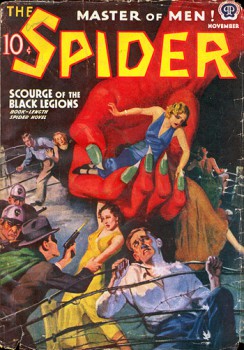 So we enter the final chapter of the Black Police Trilogy, Scourge of the Black Legions. The Spider—well, Richard Wentworth, since the secret identity thing is pretty much kaput at this point—now holds part of New York City against the Black Police. Hordes of plague victims are descending on the city, looking for a cure. Then, the worst news of all arrives: the federal government has at last decided to intervene . . . against the freedom fighters. (What? How did that happen? After all the attempts to get Washington to even notice that a police state has seized control of New York in the previous book? Any excuse to make things worse, that’s the Norvell Page motto.) Wentworth sees only one choice before him, since he doesn’t want to engage the U.S. troops: lead his men, along with faithful Nita and Kirkpatrick, on the trail to Albany to try to deal a death blow to the Master’s government at its heart.
So we enter the final chapter of the Black Police Trilogy, Scourge of the Black Legions. The Spider—well, Richard Wentworth, since the secret identity thing is pretty much kaput at this point—now holds part of New York City against the Black Police. Hordes of plague victims are descending on the city, looking for a cure. Then, the worst news of all arrives: the federal government has at last decided to intervene . . . against the freedom fighters. (What? How did that happen? After all the attempts to get Washington to even notice that a police state has seized control of New York in the previous book? Any excuse to make things worse, that’s the Norvell Page motto.) Wentworth sees only one choice before him, since he doesn’t want to engage the U.S. troops: lead his men, along with faithful Nita and Kirkpatrick, on the trail to Albany to try to deal a death blow to the Master’s government at its heart.
This leads immediately to escapades on the road, including a thrillingly written motorcycle action sequence—one of the best moments in the whole trilogy for simple crisp description—and a mob uprising in a small town taking down Black Police looters. And the Spider dons a green cape so he can stand out and not hide in the shadows as a revolutionary leader. (Come on, Dick, red is the color of the revolution!)
But the vile tide of horror continues. Wentworth is separated from Nita and Kirkpatrick. The Black Police manage to regain control from NYC. And news reaches Nita that the Spider has been slain! The tension on this obvious bit of fakery doesn’t last long, but at least Page pays it off with a great reveal and shoot-out.
Scourge of the Black Legions has the best collection of set-pieces in the trilogy, although the plot has the same tendency as the others to start heading in one direction, only to seemingly forget about it and veer off in another. For example, the exciting idea of a federal intervention on the side of the police state comes to nothing in the later chapters, the plague is forgotten entirely, and the Spider’s assault on Albany turns toward investigating the maker of the one-way mirror that the Master uses to manifest to his subordinates.
The Spider novels in general did this abrupt switching, but reading the three Black Police novels back-to-back makes Page’s haphazard approach toward plot construction even more glaring. With Scourge of the Black Legions, readers do have the attraction of huge action sections like the Spider in an aerial battle to stop the destruction of a dam (the Master’s idea of a “distraction”) and then the desperate evacuation of the town beneath it. This leads to the astonishing moment when the Spider, needing to get an injured woman to safety, shoots an innocent motorist just to commandeer his car. Wow.
The introduction to The Spider vs. The Empire State warns that the trilogy wraps up a bit too conveniently, but I don’t believe that Page disappoints at all in this department. The last book does have a swift ending, but the whole story has moved with the speed of Mercury and every Spider novels closes out with a case of whiplash. The third reveal of the Master is yet another unmasking with no surprise factor. But as a basic action closing, the massive battle between the rebels and the Black Police and subsequent race to slay the Master is exactly what readers would want from this story. It helps make The Scourge of the Black Legions the best installment in the “The Black Police” epic.
* * *
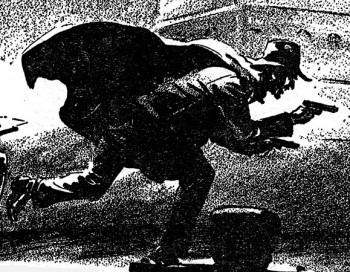 Although the three novels in The Spider vs. The Empire State contain the requisite amount of high-energy Norvell Page excitement, they aren’t among the best Spider novels that I’ve read. They fall behind some of the recent reprints such as Satan’s Murder Machines, Death Reign of the Vampire King (collected in The Spider: Robot Titans of Gotham), The City Destroyer (in The Spider: City of Doom) and others like The Red Death Reign, Secret City of Crime, and the first two installments of “The Living Pharaoh” quartet. Page may have had the catalyst of doing a Nazi allegory, but his later Spider novels often show him losing his more imaginative focus. These books lack some of the Weird Menace grotesques of his earlier work, the special lurid Grand Guignol theater: no crazy murder methods or super-weapons, few death-traps. The Black Police are basically into beatings and hangings, and as I’ve said before, the real-world managed to upstage them. Page was better when hurling craziness at his readers, like giant robot battlesuits, multi-armed statues shredding off people’s limbs, gray dust that makes whole skyscrapers collapse, death by molten silver, and rape-minded orangutans.
Although the three novels in The Spider vs. The Empire State contain the requisite amount of high-energy Norvell Page excitement, they aren’t among the best Spider novels that I’ve read. They fall behind some of the recent reprints such as Satan’s Murder Machines, Death Reign of the Vampire King (collected in The Spider: Robot Titans of Gotham), The City Destroyer (in The Spider: City of Doom) and others like The Red Death Reign, Secret City of Crime, and the first two installments of “The Living Pharaoh” quartet. Page may have had the catalyst of doing a Nazi allegory, but his later Spider novels often show him losing his more imaginative focus. These books lack some of the Weird Menace grotesques of his earlier work, the special lurid Grand Guignol theater: no crazy murder methods or super-weapons, few death-traps. The Black Police are basically into beatings and hangings, and as I’ve said before, the real-world managed to upstage them. Page was better when hurling craziness at his readers, like giant robot battlesuits, multi-armed statues shredding off people’s limbs, gray dust that makes whole skyscrapers collapse, death by molten silver, and rape-minded orangutans.
(I did not make up the last one: read The Red Death Reign, the single craziest Spider novel ever published.)
The fascist allegory is an interesting approach, but ultimately it’s dross for Page to play the same game of super-criminals that he’d been doing for the past five years. Thomas Krabacher’s new introduction makes some grand claims about the anti-fascist approach of this series, but he strikes much closer to the truth when he ends by pointing out that the stories’ “primary goal, even at the time, was to entertain and divert readers, and that they did, with the Spider’s usual fast-paced action and fantastic escapades.” The global political situation of the late 1930s encouraged Norvell Page to use a fascinating framework, but it still turns into Spider-Business-as-Usual, with a bit less imaginative lunacy. Readers expecting more from The Spider vs. The Empire State based on Krabacher’s introduction may feel disappointed. And if you’re new to the Spider, I suggest you start with the two Baen editions before tackling this one.
On the level of appearance, The Spider vs. the Empire State is one of the most beautifully designed volumes of reprinted pulp I’ve seen. Double-page spreads featuring the interior artwork from the original pulp magazine separate each of the books, and headings for chapters made from silhouettes on alternating black and white backgrounds create a mood of fascist architecture that enhances the experience. Sometimes text isn’t all you need; this presentation is a nightmare jolt itself.
Superb review, as always Ryan.
I bought The Spider vs. The Empire State when it came out, but before I could read it, it was snapped up by my 14-year old. Last I saw it, my 12-year old was reading it. Your tantalizing plot synopsis may be the closest I ever get to reading it!
John
That sounds really worth buying.
Frankly, the “Fascist Takeover allegories”…my IMO.
Imagine 9/11 and what happened after it, focusing on the conspiracy theory part. Then try to sell it in the 60s, 70s, 80s and 90s to Sci-Fi/Fantasy/Fiction magazines.
Editor from the 60s into the 70s, over a haze of pot: “Yeah, maaannnn, Da government might try to make it look like da VietCong are actually a danger to any Americans not over there shootin’ at ’em… Uh, you got some dough to help us buy some paper and ink?
Editor from the 80s:
“Sir, young sci-fi readers are actually a bit ‘right wing’ in with this new ‘cyberpunk’ thing going on as a reaction to past politics of their parents. Furthermore, the plot has too many holes. Getting a nuke on a plane isn’t that easy and they know it…what? No nuke? I know for a fact that the empire state building was hit…oh, don’t call us, we’ll call you…not…”
Editor from the 90s;
Look, just change it and have the terrorists blackmail or brainwash a customs inspector to get the nuke which you WILL put on the plane. If you just want the towers taken down, have one of the army’s developed but never used “Tactical” nukes or an Israeli “Briefcase” nuke…
But the rest, why isn’t the government silencing the “Conspiracy Theorists”. I’ve met Bush’s son at a secret ‘party’ we in some upper circles have, he’s a cocaine snorting idiot. He’d certainly be a puppet of some conspiracy, but they’d have to cover it up or the public would riot. There is no way, shape or form the public would stand for a blatantly faked election followed by a faked terrorist act and a takeover of power that involves politicians signing a document that throws the constitution out the window….or that the public wouldn’t revolt in every city openly…”
[…] Oh wait, there is a Part III to this, although it’s from a different publisher: The Spider vs. The Empire State. […]